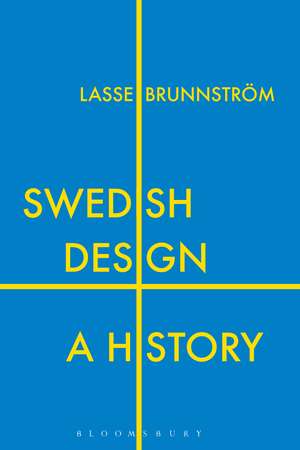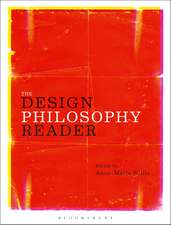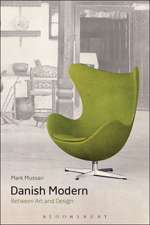Swedish Design: A History
Autor Lasse Brunnströmen Limba Engleză Paperback – 17 oct 2018
Preț: 175.85 lei
Preț vechi: 202.19 lei
-13% Nou
Puncte Express: 264
Preț estimativ în valută:
33.65€ • 36.54$ • 28.27£
33.65€ • 36.54$ • 28.27£
Carte tipărită la comandă
Livrare economică 22 aprilie-06 mai
Preluare comenzi: 021 569.72.76
Specificații
ISBN-13: 9781350000155
ISBN-10: 1350000159
Pagini: 280
Ilustrații: 60 BW and two 8pp colour plate sections
Dimensiuni: 156 x 234 x 24 mm
Greutate: 0.52 kg
Editura: Bloomsbury Publishing
Colecția Bloomsbury Visual Arts
Locul publicării:London, United Kingdom
ISBN-10: 1350000159
Pagini: 280
Ilustrații: 60 BW and two 8pp colour plate sections
Dimensiuni: 156 x 234 x 24 mm
Greutate: 0.52 kg
Editura: Bloomsbury Publishing
Colecția Bloomsbury Visual Arts
Locul publicării:London, United Kingdom
Caracteristici
More comprehensive than other histories, and questions established ideas about Swedish design
Notă biografică
Lasse Brunnström is Emeritus Professor of Design History at HDK - School of Design and Crafts, at the University of Gothenburg, Sweden.
Cuprins
Introduction1. Art to Industry: 1840s to 1910sThe nations' struggle for product dominanceEducation for increased industrial competitivenessOn a mission to improve taste and moralityThe promised land of Windsor chairs and iron stovesThe product range grows and is differentiatedInventions pave the way for the manufacturing industryThe new industrial products are aestheticized but criticisedAttempts at artistic renewal2. On the industry's terms: 1910s to 1940sSerial production enables the breakthrough of consumer goodsSwedish luxury production excelsThe Stockholm exhibition paves the way for the factory goodFunctionalist ideas pervade societyFurniture design is renewed and professionalisedProminent defenders of "good taste"The vision of the Swedish welfare state materialises3. The promotion of soft values: 1940s to 1950sWomen's understanding of home economics is utilisedThe industrial designer demonstrates his talentsIntegrated design thinkingColourful plastic replaces the black eraMobility increases and the leisure sector expandsThe foundation is laid for the Swedish safety philosophyHuman dimensions and requirements govern designThe Swedish Society of Crafts and Design attain their goal of more beautiful everyday goodsEveryday items with classic status4. Broadened design commissions: 1950s to 1980sThe industrial design profession finds its formAdvertising becomes ever more important within designBreakthrough for female designersFactory packaging drives out bulkRationality shapes everyday lifeDesign protests against a grey and unjust worldDesign with a user focus becomes a speciality5. Limitless design: 1980s to 2000sVisual values are upgradedDesign is recognised as an economic success factorA personal signature becomes increasingly importantThe budget giants step into the sphere of designThe need for strategic brand design increasesStandards of taste and the gender power order are challengedSustainability permeates designCollections, meeting places, archives, awardsBibliographyIndex
Recenzii
[There] is no other English-language book like this in the marketplace. Academic readers should be delighted as yet another barrier to Nordic design history has been stripped away by Brunnström's book.
An impressive account of Sweden's design history from its origin in craft traditions to its role in the creation of a modern industrial state. The book's broad approach shows the relation of political, social, and economic factors that contribute to design's development.
This important study significantly extends the information available in English on the subject of Swedish design. More than that, it presents an expanded take on the topic, in which the heroes of Swedish design are placed in the wider context of both Swedish and global industrial and design developments. In expanding beyond the classic fields of furniture, glass, ceramics and textiles (though these are included) and in ranging from the late nineteenth century up to the 2000s, the book challenges the traditionally narrow definitions of what 'Swedish design' can mean. This is an important contribution to our understanding of design in Sweden and how design histories can be written.
Finally, a nuanced and critical survey of Swedish design. Brunnström demonstrates that the history of Swedish design is far more variegated than is usually portrayed.
In rich, informative discussions of both historical and contemporary Swedish design, Lasse Brunnström broadens the conventional perspective on design developments beyond the familiar names of luxury products. In this copiously illustrated study, Brunnström also pushes against such standard distinctions as "industry" and "craft." Focusing on such diverse topics as manufacturing, functionalism, advertising and gender, Swedish Design: A History provides a welcome addition to the expansion of Sweden's design history beyond "Swedish Grace."
Swedish Design: A History is quite possibly the best account of popular design in Scandinavia, and an exciting addition to design history. Complicating the familiar narrative of Swedish design as blonde and handmade, Lasse Brunnström places 19th and 20th century type, textile, product, packaging, car design, and more squarely in the middle of a broader material culture. This is not just a robust history of modern Swedish design and its evolving ideals and ambitions. It is also a rich history of the everyday told through the objects that filled it and the institutions that shaped it.
An impressive account of Sweden's design history from its origin in craft traditions to its role in the creation of a modern industrial state. The book's broad approach shows the relation of political, social, and economic factors that contribute to design's development.
This important study significantly extends the information available in English on the subject of Swedish design. More than that, it presents an expanded take on the topic, in which the heroes of Swedish design are placed in the wider context of both Swedish and global industrial and design developments. In expanding beyond the classic fields of furniture, glass, ceramics and textiles (though these are included) and in ranging from the late nineteenth century up to the 2000s, the book challenges the traditionally narrow definitions of what 'Swedish design' can mean. This is an important contribution to our understanding of design in Sweden and how design histories can be written.
Finally, a nuanced and critical survey of Swedish design. Brunnström demonstrates that the history of Swedish design is far more variegated than is usually portrayed.
In rich, informative discussions of both historical and contemporary Swedish design, Lasse Brunnström broadens the conventional perspective on design developments beyond the familiar names of luxury products. In this copiously illustrated study, Brunnström also pushes against such standard distinctions as "industry" and "craft." Focusing on such diverse topics as manufacturing, functionalism, advertising and gender, Swedish Design: A History provides a welcome addition to the expansion of Sweden's design history beyond "Swedish Grace."
Swedish Design: A History is quite possibly the best account of popular design in Scandinavia, and an exciting addition to design history. Complicating the familiar narrative of Swedish design as blonde and handmade, Lasse Brunnström places 19th and 20th century type, textile, product, packaging, car design, and more squarely in the middle of a broader material culture. This is not just a robust history of modern Swedish design and its evolving ideals and ambitions. It is also a rich history of the everyday told through the objects that filled it and the institutions that shaped it.








